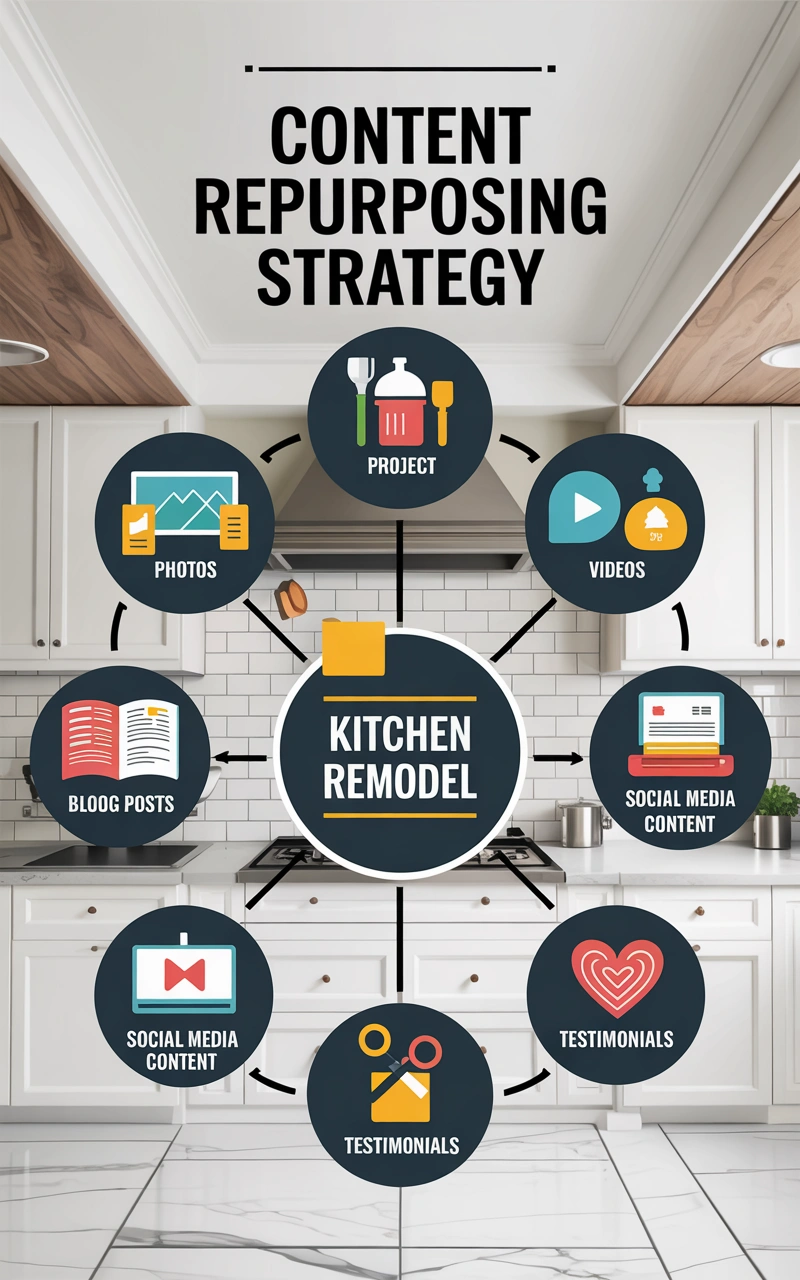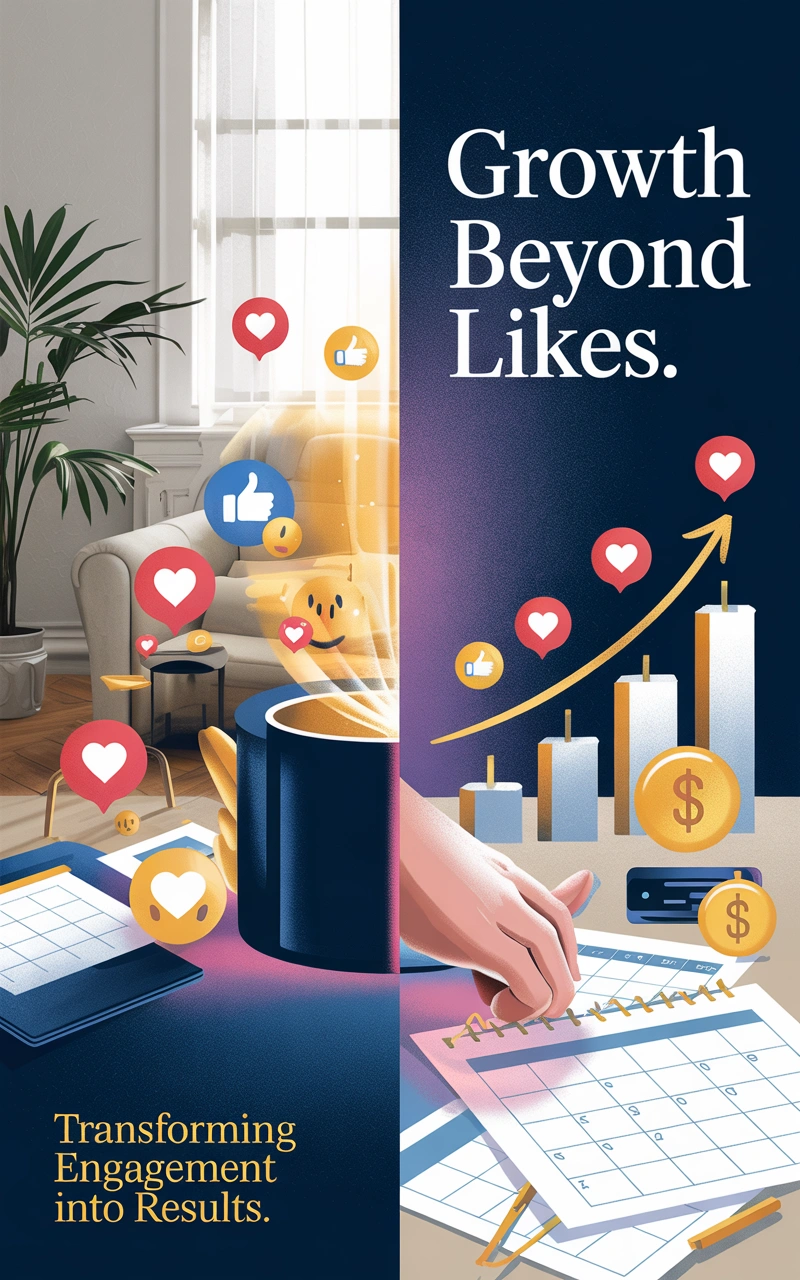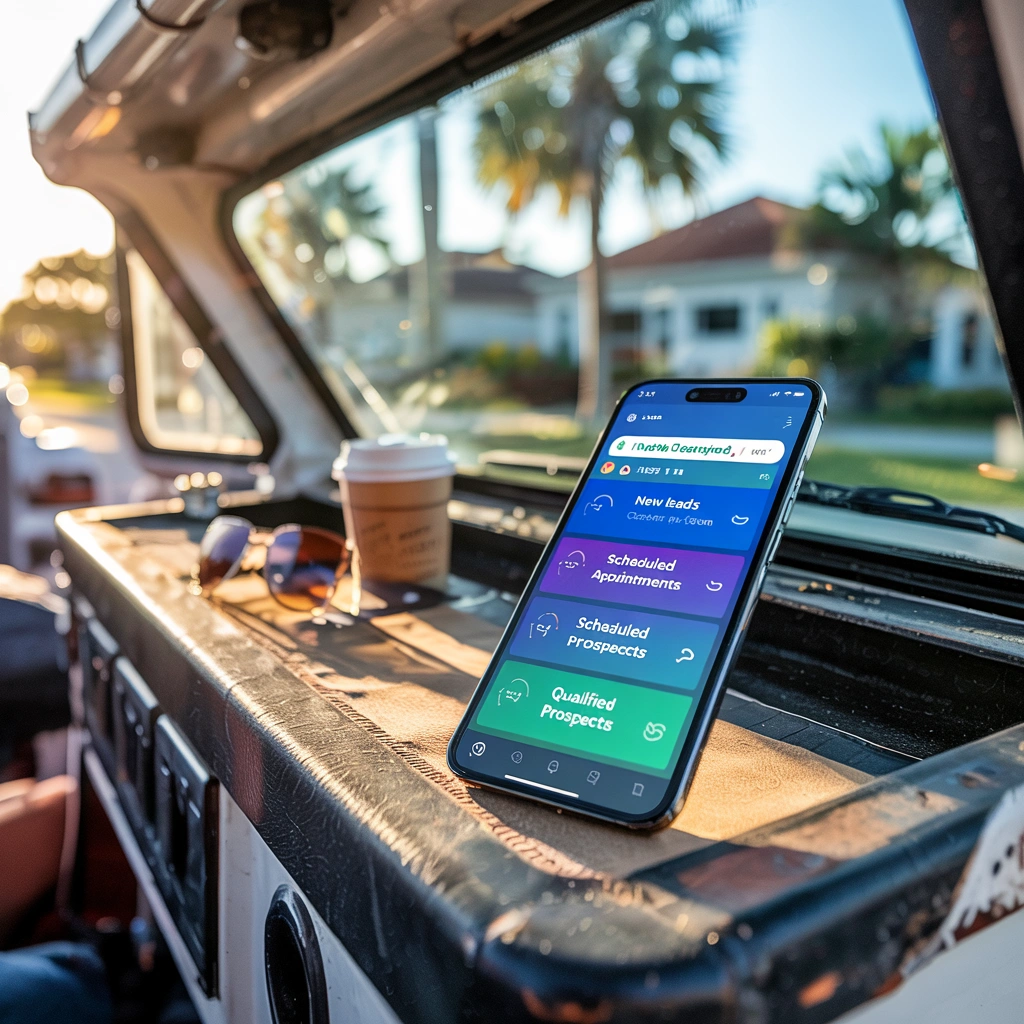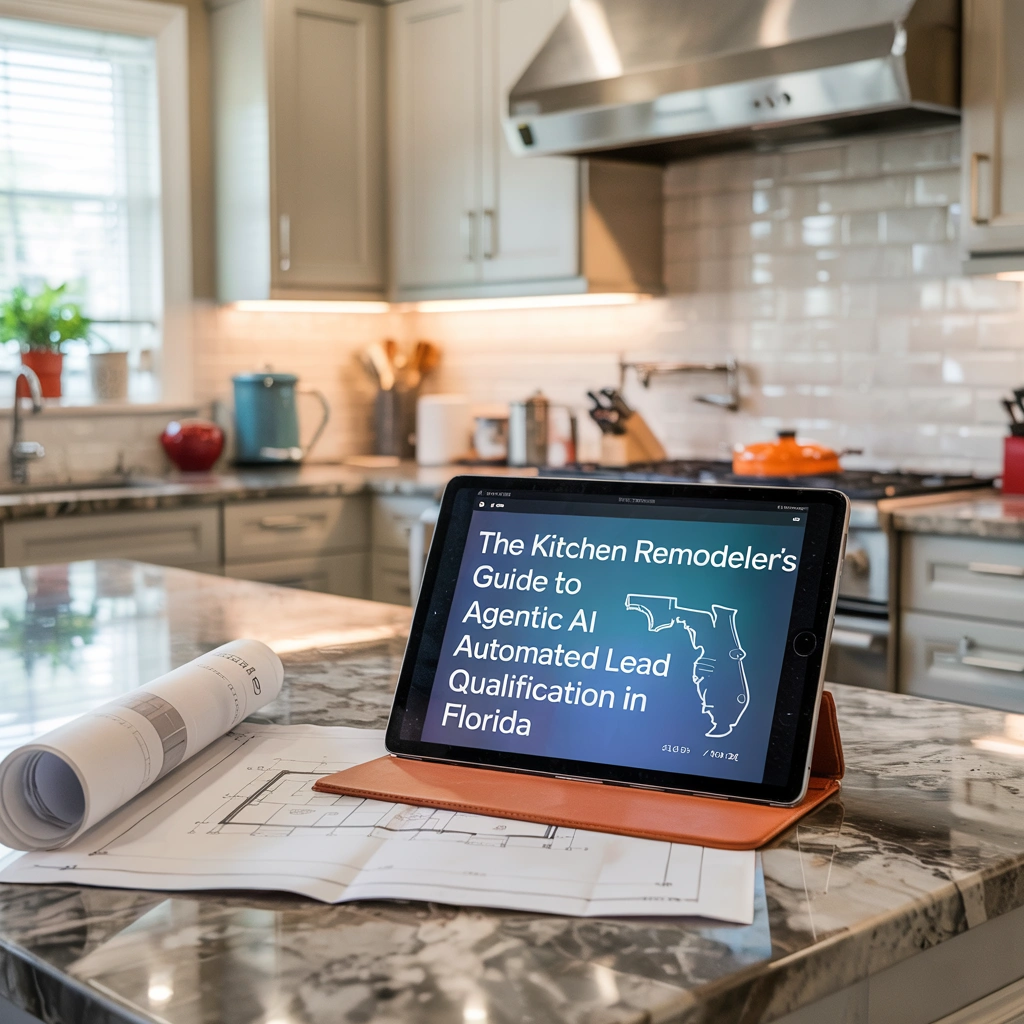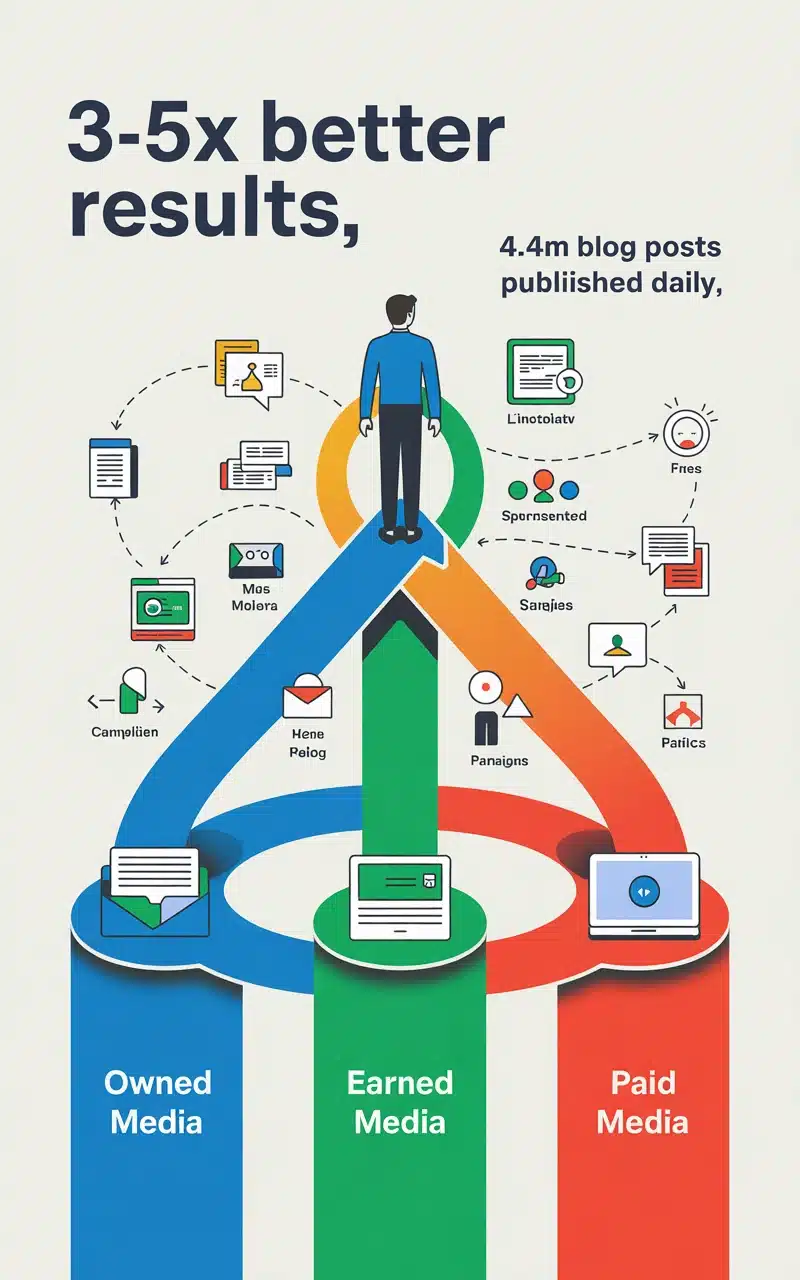
Summary: Struggling to reach your audience? Combining owned, earned, and paid media creates 3-5x better performance than single-channel approaches. You’ll gain control, credibility, and targeted reach while protecting against algorithm changes and market disruptions.
Owned, Earned Paid Media Explained – Creating a Balanced Distribution Strategy
- A balanced media distribution strategy combines owned, earned, and paid channels to maximize reach, credibility, and ROI.
- Owned media gives you complete control but has limited reach without proper amplification strategies.
- Earned media delivers the highest credibility through third-party validation but lacks predictability.
- Paid media provides immediate, targeted reach but requires ongoing investment to maintain visibility.
- Creating synergy between all three media types leads to 3-5x better performance than single-channel approaches.
The Power of Distribution: Why Your Content Strategy Needs Balance
Even the most brilliant content can disappear without an effective distribution strategy. With over 4.4 million blog posts published daily, the challenge isn’t just creating content—it’s ensuring the right people see it. A balanced approach using owned, earned, and paid media channels has become essential for breaking through the noise.
M&J Trusted specializes in helping businesses develop integrated distribution strategies that leverage all three media types for maximum impact. Understanding how these channels work together creates resilience and amplification that single-channel approaches simply can’t match.
Understanding the Three Media Pillars
What are owned, earned, and paid media?
These three media types represent distinct pathways to reach your audience, each with unique advantages:
- Owned media: Digital properties and channels your brand controls completely—your website, blog, email newsletters, social profiles, mobile apps, and company podcasts.
- Earned media: Exposure gained when others talk about your brand without direct payment—press coverage, social mentions, reviews, shares, forum discussions, and word-of-mouth recommendations.
- Paid media: Marketing channels where you pay to place content or advertisements—search engine ads, social media advertising, sponsored content, influencer partnerships, display advertising, and traditional media buys.
Why balancing all three creates resilience
Relying too heavily on any single media type creates vulnerability. Algorithm changes, cost fluctuations, or shifts in consumer behavior can quickly undermine a one-dimensional strategy. Organizations that balance all three media types report 30% higher marketing ROI and greater ability to weather platform-specific disruptions.
A balanced approach provides:
- Risk diversification when one channel underperforms
- Amplification effects as each media type enhances the others
- More touchpoints across the customer journey
- A mix of immediate results and long-term brand building
The evolution of media distribution strategy
Media distribution has transformed dramatically in the digital age. Traditional marketing relied heavily on interruptive paid advertising with limited targeting capabilities. Today’s environment offers unprecedented opportunities for precise audience targeting, real-time optimization, and measuring impact across the customer journey.
Modern distribution strategies recognize that the boundaries between owned, earned, and paid media are increasingly blurred. Content now flows between channels—paid promotion drives earned media, which directs traffic to owned properties, creating a virtuous cycle of visibility and engagement. This integration, rather than treating each channel as a separate silo, is what defines truly effective modern distribution strategies.
Owned Media: Your Digital Home Base
What exactly is owned media?
Owned media encompasses all the digital properties and channels that your brand completely controls. These platforms serve as the foundation of your online presence where you set the rules, control the content, and own the audience data.
The most common owned media channels include:
- Company websites and blogs
- Email newsletters and campaigns
- Mobile apps and branded tools
- Social media profiles (the accounts themselves, not the platforms)
- Podcasts and webinar series
- Downloadable resources (ebooks, whitepapers, templates)
Key strengths and limitations
Owned media offers several distinct advantages in your distribution strategy:
- Complete control: You determine the messaging, design, timing, and user experience
- Cost-effective longevity: Content can continue generating value for years after initial investment
- Brand building: Consistent storytelling establishes your unique voice and positioning
- Direct audience relationships: You collect and own valuable first-party data
However, owned media also has important limitations:
- Limited organic reach: Your content only reaches existing followers without additional distribution
- Resource intensive: Requires consistent content creation and platform maintenance
- Slow audience growth: Building substantial reach takes time and persistence
- Potential echo chamber: May primarily reach people already familiar with your brand
Best practices for optimization
To maximize the impact of your owned media channels:
- Quality over quantity: HubSpot found that companies publishing 16+ high-quality blog posts monthly got 3.5x more traffic than those publishing less frequently
- SEO optimization: 68% of online experiences begin with search engines, making keyword research and on-page SEO essential
- Clear user journeys: Design content with specific next steps to guide visitors toward conversion
- Content repurposing: Transform successful content into multiple formats to maximize ROI
- Data-driven personalization: Personalized email campaigns deliver 6x higher transaction rates than generic messages
Examples of effective owned media channels
REI’s Expert Advice section features over 500 in-depth guides on outdoor activities, serving both as valuable resources for their audience and powerful SEO assets that drive 10+ million organic visits annually. Their “REI Co-op Journal” further establishes their authority through storytelling that connects with their community’s values.
Mailchimp’s Resources library offers marketing guides, research reports, and tools that address their users’ challenges at every experience level. This content consistently drives qualified leads while positioning them as thought leaders in their space.
Earned Media: The Trust Multiplier
Defining earned media in today’s landscape
Earned media refers to the visibility you gain when others voluntarily talk about your brand without direct payment. It’s essentially word-of-mouth at scale, amplified through digital channels.
Today’s earned media landscape includes:
- Press coverage and journalist mentions
- Customer reviews on platforms like G2, Trustpilot, or Amazon
- Social media shares, comments, and user-generated content
- Organic influencer mentions (when not compensated)
- Backlinks from industry websites and blogs
- Podcast interviews and guest appearances
- Forum discussions and community conversations
Benefits and challenges
The power of earned media comes from its authenticity and third-party validation:
- Superior credibility: 92% of consumers trust earned media above all other forms of advertising
- Extended reach: Accesses audiences beyond your owned channels
- SEO benefits: Quality backlinks improve search rankings and domain authority
- Cost efficiency: Often delivers higher ROI than paid channels
However, earned media presents unique challenges:
- Limited control: You can’t dictate exactly what others will say or when
- Unpredictability: Results are difficult to guarantee
- Potential for negative coverage: Not all earned media is positive
- Attribution difficulties: Impact can be harder to measure directly
How to earn more media coverage
Strategic approaches to generating more earned media include:
- Create share-worthy content: Develop unique research, data visualizations, or thought leadership that naturally attracts attention
- Build a targeted media list: Identify and nurture relationships with specific journalists who cover your industry
- Develop a compelling brand story: Craft narratives that connect emotionally and differentiate your brand
- Participate authentically in communities: Add value to relevant online spaces where your audience gathers
- Create newsworthy moments: Launch innovative products, publish original research, or take meaningful stands on industry issues
- Make sharing easy: Implement social sharing tools and embed options for your content
Measuring earned media success
Effective measurement combines quantitative metrics with qualitative analysis:
- Coverage metrics: Volume, reach, and sentiment of mentions
- Engagement indicators: Shares, comments, and conversation quality
- Traffic impact: Referral traffic from earned media sources
- SEO value: Backlink quality, domain authority, and ranking improvements
- Message penetration: Presence of key messages and brand positioning in coverage
- Business outcomes: Lead generation, conversion assistance, and sales influence
Tools like Meltwater, Brandwatch, and Google Analytics can help track and attribute these metrics effectively.
Paid Media: Scaling Your Reach
Types of paid media opportunities
Paid media encompasses all channels where you pay for content placement and audience attention:
- Search advertising: Google Ads, Bing Ads targeting search intent
- Social media ads: Facebook, Instagram, LinkedIn, Twitter, TikTok, and Pinterest
- Display and programmatic: Banner ads, retargeting, and native placements
- Video advertising: YouTube pre-roll, mid-roll, and in-stream ads
- Sponsored content: Paid articles, reviews, and features on publications
- Influencer partnerships: Paid collaborations with content creators
- Traditional media: TV, radio, print, outdoor, and direct mail
Strategic advantages and considerations
Paid media offers distinct strategic benefits:
- Immediate visibility: Launch campaigns and drive traffic on demand
- Precision targeting: Reach specific demographics, interests, behaviors, and intent signals
- Scalability: Expand reach quickly when opportunities arise
- Predictability: More reliable forecasting of results compared to earned media
- Testing capabilities: Rapidly test messaging, creative approaches, and audience segments
Important considerations include:
- Ongoing investment: Visibility typically stops when spending stops
- Diminishing returns: Ad fatigue and increasing competition can reduce effectiveness
- Trust barriers: Studies show consumers trust paid advertising less than earned or owned content
- Platform dependencies: Subject to changing algorithms, policies, and costs
Budget allocation best practices
Effective budget allocation follows these principles:
- Align with customer journey stages: Distribute budget across awareness (30-40%), consideration (40-50%), and conversion (20-30%) phases
- Implement portfolio approach: Use the 70-20-10 rule (70% to proven channels, 20% to growing opportunities, 10% to experimentation)
- Account for platform efficiency: Allocate based on historical performance data and cost-per-outcome, not just audience size
- Plan for seasonality: Adjust spending to align with business cycles and industry patterns
- Set minimum viable spending: Ensure each channel receives enough budget to generate meaningful data
ROI measurement framework
A comprehensive ROI framework should include:
- Multi-touch attribution: Understand how various touchpoints contribute to conversions
- Platform-specific metrics: Track performance indicators relevant to each channel
- Cross-channel impact: Measure how paid media influences earned and owned performance
- Customer lifetime value: Look beyond immediate conversions to long-term customer worth
- Incremental testing: Use controlled experiments to determine true incremental value
- Regular optimization: Establish cadences for reviewing performance and adjusting strategy
Sophisticated marketers are increasingly using marketing mix modeling and multi-touch attribution to get a holistic view of paid media’s true impact.
Creating Synergy Across Channels
The amplification cycle between owned, earned and paid
The real power emerges when these three media types work together in coordinated cycles:
A well-designed amplification cycle might look like this: You publish an original research report on your blog (owned), promote it through targeted LinkedIn ads (paid), which generates press coverage and industry discussions (earned), driving more traffic back to your website (owned) where visitors subscribe to your newsletter, creating a sustainable audience asset.
Studies show that brands implementing integrated strategies see 2-3x higher engagement rates and up to 4x better conversion rates than those with siloed approaches. The key is designing content and campaigns with this cycle in mind from the beginning.
Case study: Disney’s integrated approach
Disney exemplifies masterful integration of all three media types in their Marvel Cinematic Universe releases:
- Owned media foundation: Disney uses Disney+, official websites, apps, and social accounts to release exclusive content like behind-the-scenes features, character spotlights, and timeline explainers that build anticipation
- Strategic paid media: Carefully orchestrated advertising campaigns across traditional and digital channels ensure massive awareness, with trailers strategically released during high-profile events like the Super Bowl
- Earned media amplification: Press coverage, fan theories, and social conversations extend reach far beyond paid efforts, with trending hashtags and viral moments driving organic visibility
For the launch of “Avengers: Endgame,” Disney created an integrated ecosystem where exclusive content on owned channels drove fan speculation, targeted ads amplified key moments, and the resulting earned media created cultural phenomena that transcended traditional marketing. The film ultimately generated over $2.8 billion globally, with marketing effectiveness multiplied through this balanced approach.
Building Your Balanced Distribution Strategy
1. Define clear business objectives
Start by establishing precisely what you aim to achieve through your distribution efforts. Different objectives require different channel priorities:
- Awareness objectives: When introducing new products or reaching new audiences, prioritize paid social ads for precise targeting and earned media for credibility
- Engagement objectives: For deepening relationships and building community, focus on owned content that encourages interaction and earned media that sparks conversation
- Conversion objectives: When driving direct sales or leads, emphasize owned channels with clear CTAs supported by retargeting ads and testimonials
For each objective, establish specific KPIs like “increase qualified website traffic by 30%” rather than vague goals like “improve awareness.” Companies with clearly defined objectives are 376% more likely to report success in their content marketing efforts.
2. Understand your audience’s media consumption
Distribution strategy must be built around your audience’s actual behavior, not assumptions:
- Develop audience personas that include media consumption habits, preferred content formats, and trusted information sources
- Map the customer journey across channels to identify key touchpoints and decision moments
- Use data mining tools like social listening, keyword research, and competitor analysis to identify trending topics and questions
Technology company Lenovo discovered through audience research that their B2B buyers were heavily consuming video content on LinkedIn during early research stages, leading them to shift 35% of their content budget to video creation and LinkedIn advertising—resulting in a 40% increase in qualified leads.
3. Audit current assets and performance
Conduct a thorough assessment of your existing distribution landscape before building new strategies:
- Content inventory: Catalog all existing content and identify gaps relative to audience needs and journey stages
- Performance analysis: Determine which channels and content types deliver the best results for each objective
- Competitive benchmarking: Analyze competitors’ distribution strategies to identify opportunities and threats
A structured audit often reveals surprising insights. One B2B software company discovered that their lowest-cost content (customer Q&A articles) generated 3x more qualified leads than their resource-intensive whitepapers, prompting a strategic shift in content investment.
4. Develop your distribution framework
Create a structured system that maps content types to appropriate channels based on format, audience, and objectives:
- Primary and secondary channels: Designate where content originates and how it’s amplified
- Content-format alignment: Match content types to their most effective delivery channels (e.g., long-form guides on blog, quick tips on social)
- Cross-promotion flows: Establish standard pathways for promoting content across channels
Document this framework as a playbook that teams can reference when planning campaigns. For example, a typical framework might specify that research reports always debut on the website (owned), get promoted via targeted LinkedIn ads (paid), and pitched to industry publications (earned)—with specific processes for each step.
5. Allocate resources strategically
Resource allocation should reflect both strategic priorities and performance data:
- Channel-based budgeting: Distribute investment across owned, earned, and paid media based on their role in achieving objectives
- Content production resources: Align creation capabilities with distribution needs (e.g., video production for YouTube strategy)
- Technology stack: Invest in tools that enable efficient content distribution and measurement
The most effective allocation models are flexible. Marketing software company HubSpot maintains a 60/30/10 budget split between owned, paid, and earned media for steady-state operations, but shifts to 40/50/10 during new product launches when immediate awareness is critical.
6. Implement cross-channel tactics
Execute your strategy with specific tactics designed for integration:
- Content atomization: Create core “pillar” content that can be broken into multiple formats and distributed across channels
- Promotion sequences: Develop standard workflows for amplifying high-performing content (e.g., boosting blog posts that exceed engagement benchmarks)
- Channel-specific optimization: Adapt messaging and formats for each platform while maintaining consistent themes
A manufacturing company created a comprehensive guide to industry regulations as downloadable content, then atomized it into blog posts, social graphics, a webinar, email sequences, and paid ads—all driving back to the main conversion asset. This integrated approach generated 4x more leads than their previous siloed campaigns.
7. Measure, analyze and optimize
Implement comprehensive measurement systems that capture both channel-specific and cross-channel performance:
- Unified dashboards: Create consolidated views that show how channels work together
- Attribution modeling: Implement systems that accurately credit touchpoints across the customer journey
- Regular review cadences: Establish weekly tactical and monthly strategic performance reviews
The most successful organizations treat measurement as an ongoing process, not a one-time event. Software company Adobe adjusts their channel mix quarterly based on attribution data, allowing them to reduce customer acquisition costs by 33% while maintaining growth targets.
Common Pitfalls to Avoid
Over-reliance on single channels
Many organizations create significant vulnerabilities by putting too many resources into too few channels:
When fitness brand Peloton built their marketing almost entirely on Facebook and Instagram, algorithm changes in 2021 dramatically reduced their reach and contributed to a 76% stock decline. Companies with balanced distribution across at least five channels report 35% higher marketing ROI and significantly more stability during platform disruptions.
Prevention strategy: Implement a “rule of thirds” where no single channel receives more than one-third of your distribution resources, and regularly audit channel dependencies to identify risks.
Lack of integration between teams and strategies
Organizational silos often prevent effective cross-channel coordination:
When content, social media, PR, and advertising teams operate independently with separate goals and metrics, opportunities for synergy are missed. A global technology company found that simply creating a shared content calendar and weekly cross-team standup meetings increased content utilization by 65% and reduced production costs by 28%.
Prevention strategy: Implement integrated planning processes, establish shared objectives across teams, and create formal workflows for cross-channel amplification of high-performing content.
Ignoring performance data and audience feedback
Distribution strategies frequently fail because they don’t adapt based on real-world performance:
A retail brand continued investing heavily in YouTube tutorials despite analytics showing that 76% of viewers dropped off within 20 seconds. By contrast, when software company Slack noticed unusually high engagement with their customer stories, they quickly shifted resources to produce more, resulting in a 41% increase in qualified leads.
Prevention strategy: Establish clear performance thresholds for each channel, implement regular review cycles, and create rapid-response processes to scale successful content and tactics.
The Future-Proof Distribution Strategy: Adaptability is Key
The media environment continues to evolve at an accelerating pace. New platforms emerge, audience behaviors shift, and technological changes disrupt established patterns. Rather than chasing every trend, future-proof distribution strategies focus on building adaptable frameworks that can evolve with changing conditions.
Key principles for building adaptability include:
- Channel-agnostic foundations: Focus on audience needs and content value rather than specific platforms
- First-party data investment: Build direct audience relationships that transcend platform changes
- Continuous experimentation: Dedicate 10-15% of resources to testing emerging channels and formats
- Modular content design: Create assets that can be easily adapted for multiple platforms
Organizations that thrive in this environment maintain core principles while continuously evolving their tactical execution. They understand that the perfect balance between owned, earned, and paid media isn’t static—it shifts with business objectives, audience behaviors, and market conditions.
The most resilient strategies aren’t the most rigid ones; they’re the most responsive. By building systems that continuously measure, learn, and adapt, you can create a distribution approach that delivers consistent results in an increasingly complex media environment.
M&J Trusted Marketing helps organizations navigate this complexity by developing integrated distribution strategies that maximize the unique strengths of owned, earned, and paid media for sustainable growth and impact.
